All About Pasargadae Iran (Photos, Location, Map)
One of the fascinating ancient monuments in Shiraz is the Pasargadae Palace of Shiraz, which, in a way, shows the authentic culture of Iranians. The city of Pasargadae was built by the order of Cyrus the Great, and the tomb of Cyrus is located in this area, which is located between the two cities of Shiraz and Isfahan.
The Pasargadae Palace of Cyrus the Great is not just an ancient building, but it is tied to the times when the Achaemenids were one of the most powerful governments in the world. Every year, a large number of tourists from inside and outside Iran come to visit the Pasargadae Palace. The ancient complex of Pasargadae Palace is one of the best sights in Shiraz and, of course, the proudest ancient building in Iran. Also, this beautiful palace is one of the 10 Iranian monuments registered with UNESCO.
Stay with us to learn more about the Pasargadae description and the Pasargadae facts.
Pasargadae History
The ancient complex of Pasargadae was the first Achaemenid capital, whose main area was 160 hectares and was surrounded by a large plain. The history of the Pasargadae region dates back to the Achaemenid period.
Throughout history, several geographical factors have made the Pasargadae plain safe for different ethnic groups, the most important of which are the existence of many mountains around the vast Murghab plain, Tang-e Bolaghi as a short way to access the ambush area, and the crossing of the Pulvar River as the only permanent river in the region.
According to the evidence, during the Achaemenid period, the Pulvar River was called the “Madian River,” and in the historical books of the Greeks, it was mentioned as the “Medus River.”
After the Achaemenid period and even during the Islamic era, this region has been of special importance for various ruling dynasties. Today, the most famous building in Pasargadae is considered to be the tomb of Cyrus, and most of the works left in it were built during the reign of Cyrus and belong to the Achaemenid period.
Pasargadae Iran Architecture
For the architecture and construction of Pasargadae Palace and the various buildings of the complex, a combination of architectural designs from Greece, Egypt, and Mesopotamia has been used.
The urartian architectural style had the greatest impact on the design of Achaemenid period buildings. That is why the architecture of Cyrus’ tomb is very similar to the ziggurat tomb.
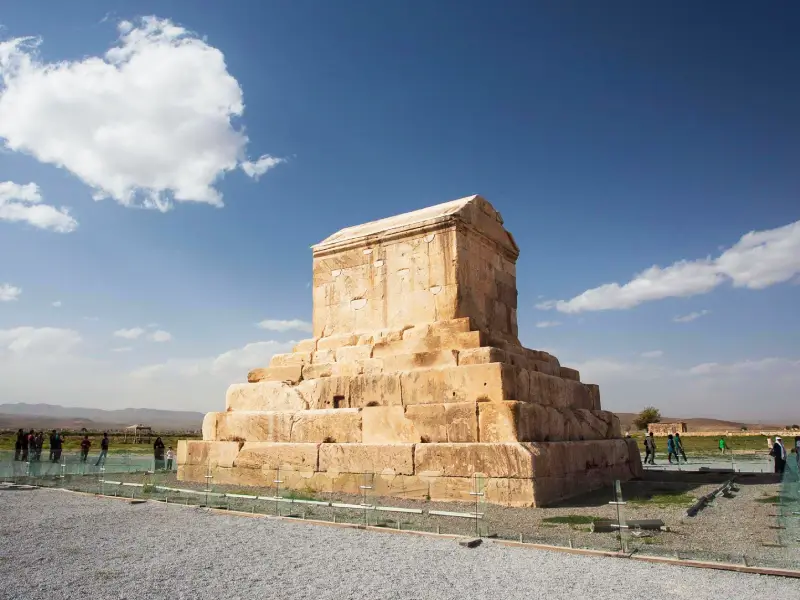
In the palace, the attractive contrast of dark and light marble stones, especially in the foundations, attracts attention. These stones were brought from around the city of Sivand, Marvdasht.
Materials such as stone, brick, clay, and wood have been used for the architecture and construction of the ancient area of Pasargadae Palace. Clay was used to fill the holes in the wall and layer on the platforms; most roofs were made of wood, primarily thick cedar trees.
The Pasargadae area was a fertile and rainy region, and therefore, a type of natural black bitumen was used to make building mortar, which prevented water penetration to a large extent. Black marble and blue stone were part of the structures of the Pasargadae complex.
Cyrus the Great ordered that the Pasargadae Palace in Shiraz be constructed in a way that would offer a beautiful view of the plains outside, in addition to the royal garden within the city.
During the Achaemenid era, great importance was attached to the beauty and use of different designs in the architecture of palaces and buildings. The last stage of the construction of Pasargadae Palace was related to the decoration of its building, for which white limestone like marble, hard blue stone, and black stone were mostly used.
What Is the Meaning of Pasargadae?
Despite the fact that about 200 years have passed since the name of Murghab Plain was changed to Pasargadae of Shiraz, the main reason for this name change is still not clear. There are many discussions and disagreements about this matter.
One of the first people to comment on this matter was Herodotus, who said in his book that “Pasargadi” was the name of the most important tribe of the Persians, from which the Achaemenids arose.
After that, Ctesias, the Greek physician of Darius II and Artaxerxes II of the Achaemenid Empire, used the name “capital of Cyrus,” and since he had lived in Iran, we can hope that he was familiar with this name. On the other hand, among the writings of experts, it can be concluded that the original name of Pasargadae was something like “Posorgad,” which is derived from the name of the royal Persian tribe meaning “the camp of the Persians,” and has nothing to do with the word “Pars.”
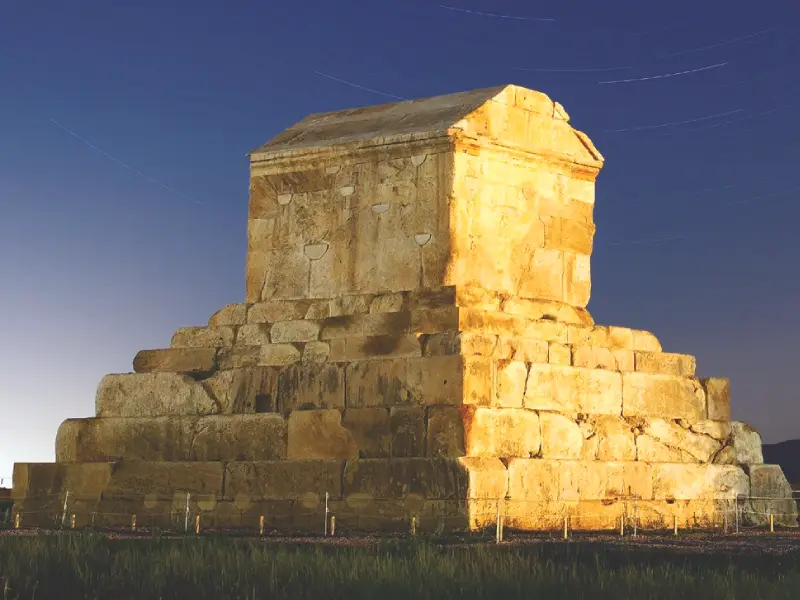
In general, there is no consensus on the naming of Pasargadae, and various words have been used for it, such as Persian fortress, the place of the Persians, Persian throne, Persian residence, the old city of Iran, and the capital of Cyrus the Great.
When Was Pasargadae Built?
Pasargadae was built by Cyrus the Great in the mid-6th century BC, specifically around 546-530 BC, as the first capital of the Achaemenid Empire. This ancient city, located in the modern Fars province of Iran, was designed to reflect the power and complexity of the Achaemenid dynasty.
This site includes several important structures, such as the tomb of Cyrus, various palaces, and the remains of a castle, which showcase the architectural and cultural achievements of the early Iranian empire.
Why Did Cyrus Choose Pasargadae?
Cyrus the Great chose Pasargadae as his capital due to its strategic location and convenient geographical location. The Murghab Plain, where Pasargadae is located, was surrounded by mountains and had a permanent water source from the Pulvar River, making it a safe and stable place.
In addition, the region was historically and culturally important, creating a symbolic link with the early Iranian peoples from which the Achaemenids originated. These factors combined to make Pasargadae an ideal place to establish a capital that would reflect the power and grandeur of Cyrus’ empire.
What Happened to Pasargadae?
Originally founded by Cyrus the Great as the capital of the Achaemenid Empire, Pasargadae eventually lost its importance after the rise of Persepolis, which became the new capital of Darius the Great. Over time, Pasargadae fell into disrepair.
Despite this, its historical significance and architectural achievements are recognized and preserved as an archaeological site. Today, the Pasargadae World Heritage site attracts researchers and tourists who come to see the remains of its ancient glory, including the tomb of Cyrus the Great and various other structures.
Pasargadae Reconstruction
The reconstruction efforts at Pasargadae have focused on maintaining and stabilizing the existing structures instead of complete reconstruction. Archaeologists and conservationists are working to protect the remains of key monuments such as the tomb of Cyrus, palaces, and other important ruins. These efforts include cleaning, repairing damaged stonework, and reinforcing foundations to prevent further deterioration.
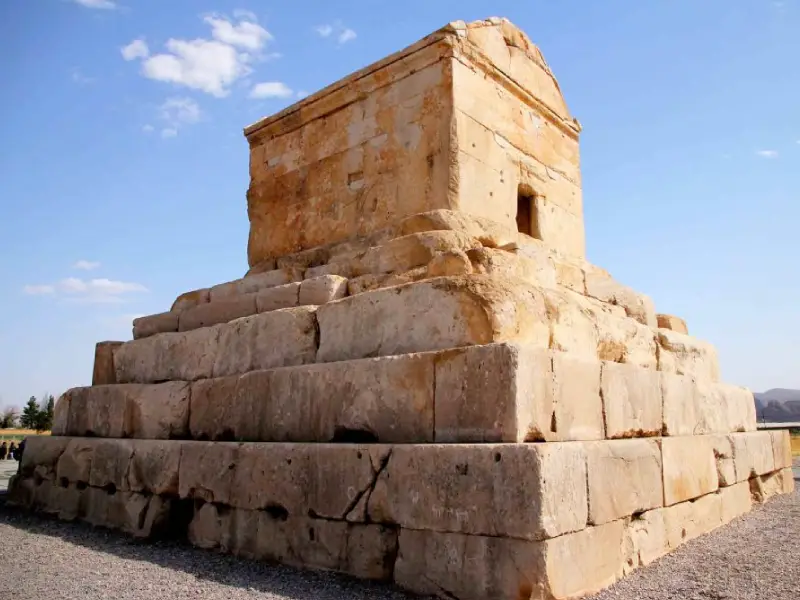
In addition to physical preservation, careful documentation and research are conducted to understand the historical context and significance of the site.
Modern technology, such as 3D scanning and digital modeling, are also used to create accurate records and visualize the original appearance of Pasargadae. These combined efforts will help Pasargadae remain an important cultural and historical site for future generations.
Tomb of Cyrus the Great
The tomb of Cyrus the Great is composed of two main parts. The first part is its stairs. The initial three stairs are constructed with a height of one meter, and the second three stairs with a height of half a meter. Following this, the second part or the main building of the tomb, is placed.
Also, there are two large holes on the roof of the tomb to reduce the pressure on the roof and increase the lifespan of the building. The whole building, which is about 11 meters high, is made of carved stone blocks that are put together without any mortar.
These blocks are placed together with iron fasteners. The tomb of Cyrus, despite its simplicity, is very admirable, magnificent, attractive, and respectable, which attracts the attention of every viewer at first glance. Pasargadae photos are proof of the beauty and popularity of this unique historical monument.
Pasargadae Tickets
When planning a visit to Pasargadae, it’s essential to be aware of the ticketing details. As of the latest information, the entrance fee for foreign tourists is approximately 500,000 Iranian Rials, while domestic visitors are charged around 200,000 Rials. Tickets can be purchased directly at the site’s entrance, and it’s advisable to carry cash, as card payments may not be accepted.
The visiting hours for Pasargadae vary by season. The operation starts from 8:00 AM and ends around 5:30 or 6 PM. To enhance the visit, guided tours are available and can provide in-depth insights into the site’s historical context. It’s recommended to check the official website or contact local tourism offices for the most current information before planning your visit.
Pasargadae Location
To reach Pasargadae, you will pass the beautiful city of Shiraz from the first route and enter the Shiraz-Marvdasht road. This route is about 134 kilometers long.
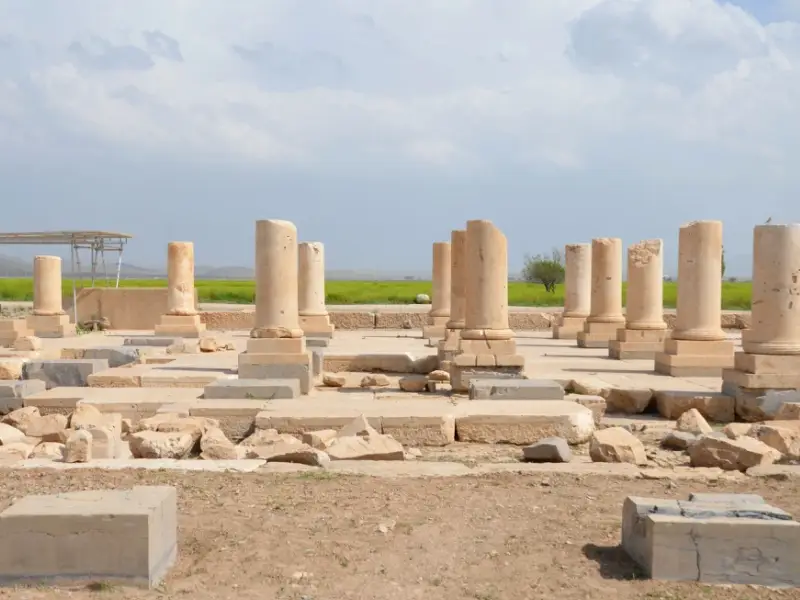
On this route, after passing Marvdasht, you will enter the Saadat Shahr-Safa Shahr highway. Continue the path towards Pasargadae with the help of the signposts until you finally reach the Murghab Plain. When you climb the hills of the Murghab Plain, you will see the enchanting Pasargadae plain (Location on map).
In the second route, you can travel from Isfahan towards Shiraz and then reach Marvdasht. To do this, you need to get to the Abadeh-Safa Shahr highway, also known as Highway 65. After passing Safa Shahr, enter the Saadat Shahr-Safa Shahr highway and continue towards the Murghab Plain.
Pasargadae Map
The location of Pasargadae Boulevard on the map is in District 4 of Shiraz and passes through Pasargadae, Qalishuyi, Paeiz, and Siraj areas. One of the main roads of these areas is Pasargadae Boulevard, which is considered one of the important streets of Shiraz.
This area is about 82 km from Persepolis and 135 km from the center of Shiraz. The Pasargadae region has a great reputation in the world, and many people from all over the world travel to Fars province to see it.
Pasargadae Reviews
Pasargadae, the ancient capital of the Achaemenid Empire, is a site of profound historical significance. Visitors often highlight the Tomb of Cyrus the Great as the centerpiece of their experience. While some note that the site lacks extensive standing structures, many appreciate the unique atmosphere that evokes a deep connection to the past. The site’s expansive layout, encompassing remnants of palaces and gardens, offers a glimpse into the grandeur of ancient Persian civilization. Travelers recommend combining a visit to Pasargadae with nearby historical sites like Persepolis to enrich the cultural experience.
The serene environment of Pasargadae allows visitors to reflect on the legacy of Cyrus the Great and the architectural innovations of the Achaemenid era. Despite the minimalistic ruins, the site’s historical context provides a compelling narrative that resonates with history enthusiasts. The surrounding landscape adds to the site’s allure, offering picturesque views that enhance the overall visit. For those interested in ancient history and archaeology, Pasargadae presents an invaluable opportunity to explore the roots of Persian heritage.
Final Word
Pasargadae, the ancient capital of the Achaemenid Empire, founded by Cyrus the Great, is an example of the rich architectural and cultural heritage of ancient Persia. Pasargadae, with its unique combination of Greek, Egyptian, and Mesopotamian influences, is a unique example of the genius and greatness of its time.
As a UNESCO World Heritage Site, a visit to Pasargadae offers a wonderful journey through history, inviting travelers to explore its magnificent ruins and discover the legacy of one of the world’s greatest empires.
A trip to Iran would not be complete without experiencing the amazing beauty and historical importance of Pasargadae.
Are you planning to travel to Iran and looking for an Iran resort? Consider Matinabad Eco-resort.

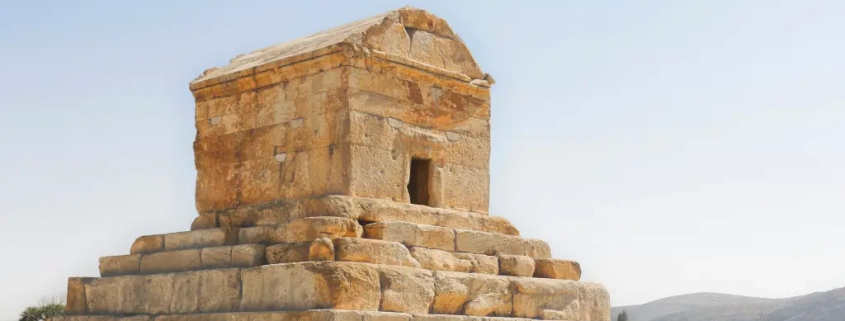



Leave a Reply
Want to join the discussion?Feel free to contribute!